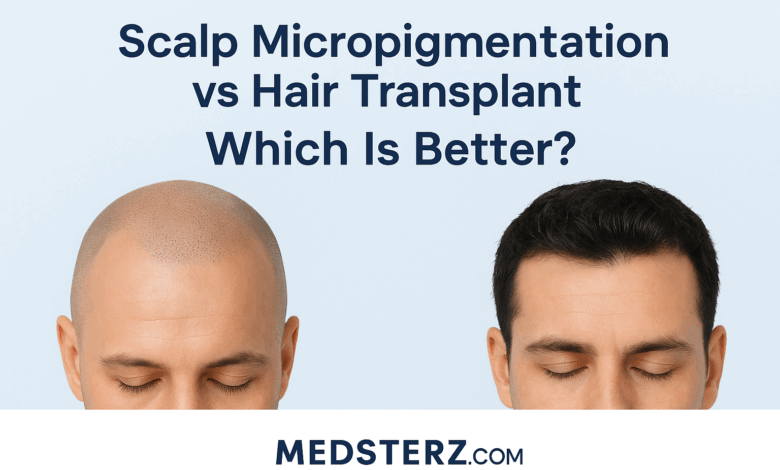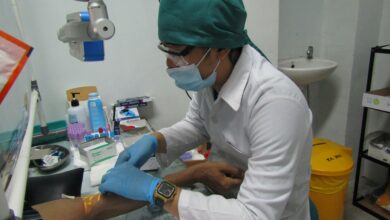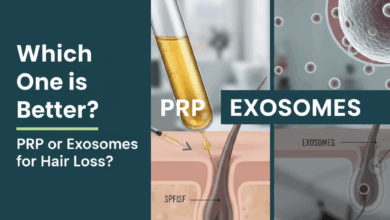Scalp Micropigmentation vs Hair Transplant – Which Is Better in 2025?
Discover the key differences between scalp micropigmentation and hair transplant surgery — including results, cost, recovery, and which treatment is right for you.

Hair loss is one of the most common aesthetic concerns among both men and women. With new advancements in hair restoration, two popular options often compared are Scalp Micropigmentation (SMP) and Hair Transplant Surgery.
But which one is actually better for you? Let’s explore how each treatment works, their pros and cons, results, and how to choose the right option.
What Is Scalp Micropigmentation (SMP)?
Scalp Micropigmentation is a non-surgical cosmetic procedure that creates the illusion of fuller hair using tiny pigment deposits in the scalp.
It’s often called a “hair tattoo” because it mimics natural hair follicles.
How SMP Works
-
A trained SMP specialist uses micro-needles to implant natural pigments into the upper dermis of the scalp.
-
The dots are matched to your natural hair color and density.
-
The final result gives the appearance of closely-shaven hair or added density in thinning areas.
Ideal Candidates for SMP
-
Men with receding hairlines or diffuse thinning
-
Women with visible scalp due to hair loss
-
People who want a buzz-cut look
-
Patients who cannot undergo surgery or have insufficient donor hair
What Is Hair Transplant Surgery?
A Hair Transplant is a surgical procedure that involves harvesting hair follicles from a donor area (usually the back of the scalp) and implanting them into bald or thinning regions.
Techniques Used
-
FUE (Follicular Unit Extraction): Individual grafts are extracted and implanted.
-
FUT (Follicular Unit Transplant): A strip of scalp is removed and divided into grafts.
Ideal Candidates for Hair Transplant
-
People with permanent hair loss (male/female pattern baldness)
-
Sufficient donor hair available
-
Looking for natural, permanent hair regrowth
Key Differences Between SMP and Hair Transplant
| Feature | Scalp Micropigmentation (SMP) | Hair Transplant Surgery |
|---|---|---|
| Type of Procedure | Non-surgical (cosmetic tattoo) | Surgical (follicular grafts) |
| Recovery Time | 2–3 days | 7–14 days |
| Pain/Discomfort | Minimal | Mild to moderate |
| Results | Immediate visual density | Gradual regrowth (6–12 months) |
| Longevity | 3–5 years (touch-ups needed) | Permanent results |
| Cost (2025 average) | $400–$1500 per session | $1500–$4000 depending on grafts |
| Maintenance | Occasional pigment refresh | Minimal after full regrowth |
| Best For | Shaved look, density illusion | Actual new hair growth |
Which Is Better – SMP or Hair Transplant?
The answer depends on your goals, hair loss type, and expectations.
Choose SMP If:
-
You want instant results without surgery.
-
You prefer a clean, shaven, or closely-trimmed look.
-
You have limited donor hair or previous transplant scars.
-
You’re looking for an affordable, low-downtime solution.
Choose Hair Transplant If:
-
You want real, growing hair that you can style naturally.
-
You have enough donor hair.
-
You’re okay with a longer recovery and higher cost for permanent results.
Can SMP and Hair Transplant Be Combined?
Absolutely.
Many patients undergo Hair Transplant first and later do SMP to enhance density, cover scars, or refine hairline details.
This combination can create the most realistic and fuller appearance possible.
Results and Longevity
-
SMP results are immediate but may need touch-ups every few years as pigments fade.
-
Hair Transplant results appear gradually over 6–12 months as transplanted follicles grow naturally.
Aftercare & Recovery Tips
For SMP:
-
Avoid washing or sweating for 3–5 days.
-
Keep scalp moisturized.
-
Protect from sun exposure.
For Hair Transplant:
-
Sleep with head elevated for 5–7 days.
-
Avoid touching or scratching grafts.
-
Start mild shampooing after 5–7 days as advised.
-
Follow your surgeon’s PRP or medication plan to boost results.
Final Verdict
Both Scalp Micropigmentation and Hair Transplant have their own strengths.
If you want natural regrowth and long-term transformation, hair transplant is the way to go.
If you prefer a quick, non-surgical fix with minimal downtime, SMP might suit you better.
The best decision is always made after a consultation with a qualified hair restoration specialist who can assess your scalp, donor area, and expectations.
FAQs
1. Is SMP painful?
Mild discomfort only; numbing creams are used to make it tolerable.
2. How long does a hair transplant take to heal?
Most people recover in 10–14 days, but full results show in 6–12 months.
3. Can SMP damage existing hair?
No, it’s superficial and does not affect natural hair follicles.
4. Which looks more natural?
Hair transplant gives real hair growth; SMP provides the illusion of density.
5. Can I do both treatments together?
Yes, combining them often gives the most refined and fuller outcome.





